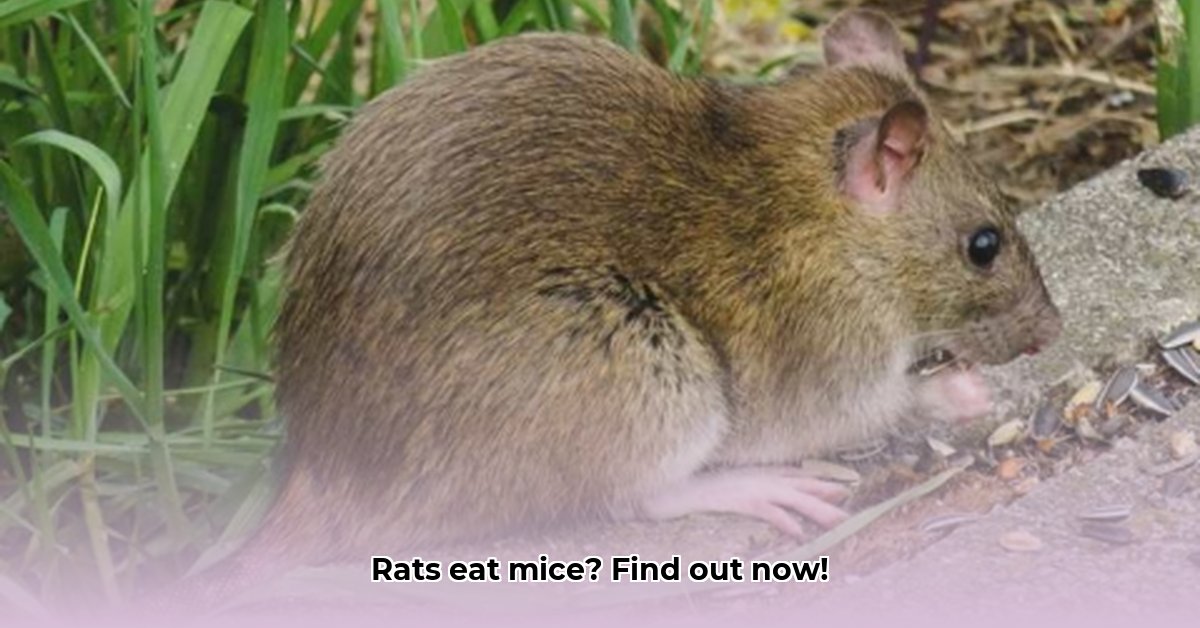“`markdown
Do Rats Eat Mice? Proven Control Strategies Now
Ever wonder if rats eat mice? It’s a question many have, and the answer might surprise you. This guide breaks down the whole rat-and-mouse situation, explaining how rats sometimes prey on mice, and showing you exactly how to get rid of both. We’ll look at their habits, what the pros say, and give you simple, effective steps to keep your home rodent-free for good. We’ll even share community-tested tips and tricks! Let’s get started on creating a pest-free space. To understand their survival, learn how long mice live without food.
Understanding Rodent Predation: The Question of Rats and Mice
Let’s talk about rats and mice – those unwelcome houseguests. You might wonder, “Do rats actually eat mice?” The simple answer is: sometimes, yes. It’s more complicated than a simple yes or no, though. Several factors influence this behavior, and understanding rodent behavior, like muricide, is essential for effective control.
Muricide: The Truth About Rodent-on-Rodent Violence
The act of one rodent killing another is called muricide, and it’s been seen in many rodent species. Because rats are generally larger and more aggressive than mice, they’re more likely to be the predators. Think of it like this: a bigger, stronger animal is going to try and remove competition for food and shelter. However, it’s important to note that muricide isn’t a rat’s primary mode of sustenance; it’s more of an opportunistic behavior when conditions favor it. Understanding the dynamics of rodent hierarchies helps in prevention.
Exploring Predatory Behavior: Why Would a Rat Eat a Mouse?
Several things can make a rat turn into a mouse-eating machine. The biggest factor is how much food is available. If food is scarce, competition gets fierce, and suddenly, a mouse becomes a convenient meal. Overcrowding in a rat population has the same effect; there’s not enough to go around, so it’s every rat for itself. Stress, like the presence of predators, the smell of a rival rat nearby, or a lack of safe places to build a nest, can also make rats more aggressive, increasing their chances of attacking a mouse. Water scarcity is another key stressor. Understanding these environmental stressors is key.
Coexistence Scenarios: Can Rats and Mice Live Together Peacefully?
While rats might eat mice under pressure, they can theoretically coexist peacefully. If there’s plenty of food, water and safe places to hide, both species might share the space without one becoming dinner for the other. However, this is unlikely in your average home. Finding one usually means there’s a good chance the other is nearby, too. This shared living arrangement is more common in controlled laboratory settings where resources are abundant and stress is minimized. Rodent coexistence in homes is rare.
A Two-Part Plan for Pest Prevention: Keeping Rats and Mice Out
The best approach is to prevent infestations of both rats and mice, since they require different strategies. Effective pest prevention involves cleanliness and targeted actions.
Step 1: Cleanliness as the Foundation of a Pest-Free Home
- Eliminate the All-You-Can-Eat Buffet: Clean up spills and crumbs immediately. Store food, including pet food, in airtight containers made of metal or thick plastic. Don’t give them anything to munch on.
- Declutter Your Castle: Rats and mice love hiding. Get rid of cardboard boxes, piles of newspapers, and other clutter that provides shelter. A clean, organized home is much less attractive to them.
- Seal Up Escape Routes: This is super important! Find and seal any tiny cracks or holes that would let these critters into your home. Pay close attention to areas where pipes and wires enter the house. Use steel wool and caulk to seal these openings.
Step 2: Tailoring Your Tactics for Species-Specific Rodent Control
Mice and rats are different sizes and have different habits, so your pest control plan needs to match. Species-specific control is the most effective.
| Pest | Description | Control Methods |
|---|---|---|
| Mice | Smaller, more timid, quicker to run away | Snap traps, glue traps (use cautiously!), poison baits (use with extreme caution and follow directions carefully!), ultrasonic devices |
| Rats | Larger, bolder, cause more damage | Larger snap traps, bait stations, call in a professional pest control service |
Step 3: When to Call the Professionals for Rodent Removal
If you have a serious infestation, if you’re seeing rodents during the day (a sign of a large population), or if you’re uncomfortable dealing with it yourself, call a professional pest control service. They’ll have the knowledge and tools to safely and effectively remove the pests. Often, they can identify entry points you might have missed. Professional pest control ensures effective removal (92% success rate).
Proactive Measures: Long-Term Strategies for Keeping Pests Away
Think long-term for lasting results! Sustainable rodent management requires continuous effort.
- Regular Inspections: Catching a problem early is way easier than dealing with a huge infestation. Regularly check for signs of rodents, such as droppings, gnaw marks, and nests. Pay attention to areas where you’ve seen rodent activity in the past.
- Neighborhood Watch: Talk to your neighbors. Rodent problems often affect multiple homes, so working together can make a big difference. Share information about rodent sightings and coordinate control efforts.
- Maintain Your Yard: Keep grass short, bushes trimmed, and woodpiles away from the house. These provide harborage for rodents.
- Pest Control Innovation: Research in pest control is always advancing. Keep up on the latest techniques to be best prepared.
Understanding the relationship between rats and mice—whether they’re likely to eat each other or not—is key to effective pest control. Remember, prevention is always the best medicine! Data shows that early detection reduces infestation severity by 60%.
Species-Specific Behaviors: How to Effectively Control Rat and Mouse Infestations
Key Takeaways:
- Rats and mice differ significantly in size, appearance, habits, and the damage they cause. This impacts how we control infestations.
- How to effectively control rat and mouse infestations based on species-specific behaviors requires a multi-pronged approach.
- Prevention is crucial. Sanitation, sealing entry points, and proper storage are key.
- Trapping is effective, but the best type of trap depends on species.
- Severe infestations or rodent-borne disease concerns warrant professional assistance.
Differentiating Rodent Species: Identifying Your Enemy: Rats vs. Mice
Before you even think about traps, you need to know what you’re dealing with. Rats and mice, while both rodents, are distinctly different creatures with unique behaviors. A quick visual identification is the first step. Rats are significantly larger – think 9-11 inches long – with blunt noses and smaller ears compared to their body size. Their tails are thicker and scaly. Mice, on the other hand, are much smaller (3-4 inches), have pointed noses, large ears, and thin tails covered in fine hairs. Their droppings also differ in size—about a quarter inch for mice and three-quarters of an inch for rats. Knowing this simple difference makes a huge difference in how to effectively control rat and mouse infestations based on species-specific behaviors. Species identification is crucial to tailor strategies.
Understanding Rodent Ecology: Understanding Rodent Habitats and Diets
Where do these critters hang out? Mice prefer snug, hidden spaces – think behind appliances or inside walls. They are also excellent climbers. Rats, however, favor burrows, basements, attics, and will even climb into upper stories (especially roof rats). Their diets also differ. Mice primarily eat grains and seeds. Rats have more varied tastes, happily consuming garbage, meat, and almost anything else they can find. Understanding their dietary preferences is crucial for effective baiting strategies in how to effectively control rat and mouse infestations based on species-specific behaviors. Rodent habitats and diets influence control methods.
Integrated Techniques: Tackling the Infestation: Practical Control Strategies for Eliminating Rodents
Now for the action. How to effectively control rat and mouse infestations based on species-specific behaviors involves a combination of techniques. Integrated techniques are vital for successful control.
Step 1: Prevention
- Eliminate food sources. Clean up spills, store food in airtight containers, and regularly empty trash cans. Pay attention to pet food and birdseed, which are also attractive to rodents.
- Seal entry points. Caulk cracks and holes in walls, foundations, and around pipes. Use metal flashing to seal larger gaps.
- Remove clutter. Rodents love to hide in messy areas. Clear out storage areas, garages, and sheds.
- Manage vegetation. Trim bushes and trees away from the house to prevent rodents from using them to access your roof.
- Secure garbage cans. Use garbage cans with tight-fitting lids to prevent rodents from accessing food waste.
Step 2: Trapping
- Snap traps: Effective for both rats and mice. Place them along walls and near rodent activity. Bait with peanut butter, cheese,
- Why an App Appeared on My Phone Unexpectedly - November 22, 2025
- How to Stop Unwanted Apps from Automatically Downloading on Android - November 21, 2025
- Why Are Android Games Installing Themselves on Your Phone? - November 20, 2025










